H. P. Lovecraft received direct information on Robert E. Howard’s death from Dr. I. M. Howard dated June 29, 1936. Wherein Dr. Howard wrote:
“He slipped out of the house, entered his car which was standing in front of the garage, raised the windows and fired a shot through his brain. . .He shot himself just above the temple. It came out in the opposite side, just above and behind the left ear.”
Robert E. Howard used a pistol to perform the suicide. That is not a surprise, as he liked pistols. He mentioned in a letter to Wilfred Blanch Talman of toting an old .44 in the waistband of his pants at age 14-15. He mentioned having a borrowed “old Frontier model Colt .45 single action.”
Robert E. Howard wrote a letter to August Derleth in March 1933 in which he discussed firearms in a fair portion of the letter. He mentions being a rather poor shot with hunting. “I never did much care about it, and I haven’t hunted at all in years.”
He mentions the British “preferred heavy bored guns with powerful shocking power, but low velocity.” He compares express rifles of English hunters to “comparatively light, high powered Savages, Winchesters and Springfields of American hunters.”
Then he has a confusing sentence: “The Germans and Austrians, to my mind over do the latter phase just a little with their Mausers, Lugers, and Mannlichers.”
Howard is probably mixing rifles and pistols. The German Mauser is famous of course being used in two world wars by the Wehrmacht. There is a saying that you use an American Springfield 1903 for target competition, a German Mauser for hunting, and the British Lee-Enfield for battle. I use an “8 mm” (actually 7.92) Mauser for deer hunting. It was originally used by some Wehrmacht soldier in WW2. Velocity is 2855 feet per second with an effective range of 1000m.
The Austro-Hungarian Empire used the Mannlicher rifle from the 1890s through WW1. It used an 8 mm rimmed cartridge. It had a velocity of 2,000 to 2,400 ft/s depending on the cartridge.
Luger did produce a couple prototype rifles never accepted by the German Army.
Mauser, Luger, and Mannlicher all produced pistols. Howard states “I’ve heard of Luger bullets going right through a bone without breaking it.” It appears that Howard had abruptly switched from discussing rifles to pistols. In Howard’s fiction, rifles are used but at heart, he was a pistolero. His eager discussion of John Wesley Hardin or Billy the Kid in letters show a fascination with the manual dexterity of the quick but accurate draw. His western stories feature climaxes with pistol play.
Howard might have had the Steyr-Mannlicher M1912 in mind. It used a powerful 9 x 23 mm cartridge and has a velocity of 1,230 ft/s, which makes it quite zippy. It also came in 9 mm Luger.
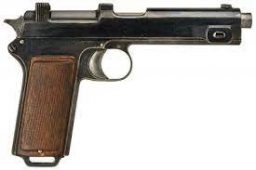
Steyr M1912
Mauser produced a rather famous pistol- the C/96. The C/96 used a 7.63 x 25 mm cartridge with a velocity of 1,394 ft/s. It also had an effective range of 200 meters. It had the highest velocity pistol cartridge until the .357 Magnum came out in 1935.
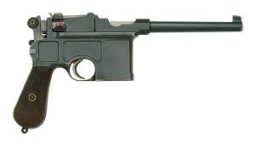
Mauser C-96
W. A. Fairbairn & E. A. Sykes wrote in their shooting manual Shooting to Live: “We have seen terrible damage caused by a Mauser automatic, caliber 7.63 mm, of military pattern. We have in mind the case of a man who was hit in the arm by a solid full-jacketed bullet from a weapon of this type. Though he was in the hospital within half an hour of being shot, nothing could be done to avoid amputation, so badly were the bone and tissue lacerated. Perhaps ‘pulped’ would convey our meaning more exactly. . .Nothing is so feared, rightly or wrongly, as the Mauser military automatic.”
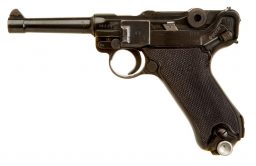
Luger
The P-08 Luger. We all know the pistol from many a war movie. The first Lugers used the 7.65 (.32 ACP) cartridge. By 1904, it had been adapted to 9 x 19 mm Parabellum cartridge, now the standard pistol cartridge used around the world today. Muzzle velocity is 1148-1312 ft/s with an effective range of 50 meters. It has 462 joules of energy.
Howard continued in his letter to Derleth:
“I’ve heard of Luger bullets going right through a bone without breaking it. When a bullet from a Colt .45 automatic hits a bone, it plays havoc with it. I suppose a Luger automatic has the highest velocity and flattest trajectory of any pistol, but is shocking power is comparatively small.”
The .45 ACP used in the M1911 pistol is around 230 grains vs. 127 in the 9 mm Parabellum. Velocity is 990 ft/s with 482.7 joules of energy. There is little difference in energy. As Peter Grant wrote at his Bayou Renaissance man blog:
“The more energy a round is able to transfer to an assailant, the more effective it’s likely to be at neutralizing him.”
Robert E. Howard believed in the big and slow bullet for the takedown.
Novalyne Price on a drive with Robert E. Howard in his ’31 Chevy:
“I reached down and opened the glove compartment of his car. In it was a big thirty-eight revolver. I took it out before Bob realized what I was doing. He caught his breath and reached for the gun.” (One Who Walked Alone).
It is impressive that Novalyne Price as a female could tell the difference in a pistol between revolver and automatic and know the caliber.
The .38 revolver, specifically the .38 Special, was a popular side arm of the time. .38 means 38/100 of an inch in diameter. It has .357 inch bullet diameter, .379 base diameter. The cartridge is 9 x 29 mm with a rimmed case. It was developed in 1898 as an improvement on the .38 Long Colt used by the U.S. Army at the time. The Long Colt was not penetrating Moro shields in the southern Philippines. The round originally was loaded with black powder. The Smith & Wesson Model 10 was the classic design for .38 revolvers with variations over the decades. A 158 grain (10.2 gm) .38 round has a muzzle velocity of 767 ft/s (234 m/s), muzzle energy of 310 ft-lbf (279 j) and maximum pressure of 14,500 psi. The .38 Special is known for accuracy and manageable recoil. It is a slow moving round in comparison to newer cartridges due to its black powder origin. There were complaints in law enforcement in the 50s and 60s that it would fail to stop assailants in some cases resulting in development of more powerful cartridges.
A .38 Special is generally the revolver you see in most old detective and crime movies, especially the (snub nose) Colt Detective Special introduced in 1927.
Howard wrote to August Derleth in the letter from March 1933:
“The old Colt .45 sixshooter (sic) has the most terrific shocking power of any hand gun, but its velocity is not so great as that of several arms. The Colt .38-40 is about the ideal gun, as far as I can see. Its shocking power is little inferior to the .45, while in range, and velocity it is superior to any other caliber sixshooter using lead bullets– which naturally carry less velocity but more shocking power than steel-jacketed automatic bullets.”
The .38-40 is actually .40 caliber and derived from Winchesters .44-40. It does have 1,160 ft/s velocity with 729 joules of energy. So Howard is correct on that round’s potency.
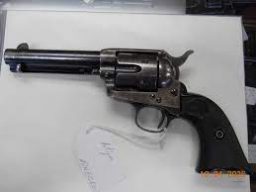
Colt .38-40 Single Action
Was the revolver Novalyne Price found in Howard’s car actually a Colt .38-40?
Robert E. Howard did mention owning a Colt .25 ACP pistol that jammed every fourth or fifth shot in a letter to Wilfred Blanch Talman, March 1932. Ian Fleming armed secret agent James Bond with a Beretta .418 in 25 auto in the first five novels. The infamous Westies gang in Hell’s Kitchen in the 1970s and early 80s used Beretta .25s for contract mob hits.
E. Hoffmann Price wrote to L. Sprague de Camp in 1977:
“Bob took pistol from glove compartment. Gun was an automatic. Whether .32 or .38, I don’t recall. Hard to tell without a close look. My impression has been, .38 Colt, but neither make nor caliber is warranted.”
The .38 Colt Auto also known as the “Super” was a caliber that never enjoyed great popularity. It is a 9 x 23 mm semi-rimmed cartridge designed by John Browning. A 125 grain (8 gm) bullet had a velocity of 1,100 ft/s (340 m/s) with an energy of 336 ft-lbf (456 J). So this is a powerful round in comparison to the .32 ACP. The round was used by Colt and a couple Webley automatic pistols. Raymond Chandler had his detective Philip Marlowe using a .38 Auto in some of the novels.
L. Sprague de Camp used an interview with Jack Scott, Feb. 21, 1980 for material in Dark Valley Destiny mentioning that Dr. Isaac Howard removed Robert’s pistol from the glove compartment of his car. REH used Lindsey Tyson’s pistol for the suicide. De Camp states Howard had the same model as Tyson. That pistol owned by Lindsey Tyson was a 1903 Colt “Hammerless” Pocket Model, .380 ACP. Colt made the pistol originally in .32 ACP and then in 1908 in .380 ACP. The .380 variant could be converted to a .32. The New York City Police used the .380 model starting in 1913. The Belgian Army bought 24,002 pistols in 1915 in .32.
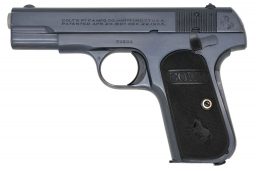
Colt 1908 .380
The Colt 1908 .380 is 6.75 inches long, height is 4.5 inches, width 1 inch, weight 24 ounces. The magazine holds 7 rounds.
The .380 ACP cartridge is 9 x 17 mm in dimensions. A 100 grain (6 grams) bullet has a velocity of 975 ft/sec (297 m/s) with energy of 211 ft-lb f (286 j). It was a cartridge used by the armies of Hungary, Czechoslovakia, Netherlands, Yugoslavia, and Italy after WW1. The OSS used the pistol in WW2. The .380 ACP was used by police in Europe until the 1980s.
William Fairbairn who created the idea of the SWAT team was in charge of training of the Shanghai Municipal Police in the 1920s. He adopted the Colt 1908 .380. They were modified so the safety could not be used. Officers carried the pistol with no cartridge in the chamber. Fairbairn along with Eric Sykes developed British commando hand to hand fighting and developed the Sykes-Fairbairn commando knife.
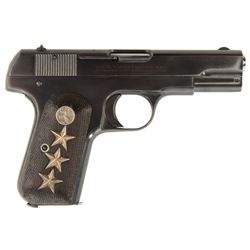
Gen. George S. Patton’s Colt
George S. Patton had a 1908 Colt .380 with special handgrips. Al Capone, Bonnie Parker, and John Dillinger all carried this pistol. Tojo attempted suicide with one. Gavrilo Princeps used a .380 FN Browning to assassinate the Archduke Franz Ferdinand and his wife Sophie in 1914, thereby sparking WW1. Hitler used a .380 to commit suicide. Edward Woodward as Robert McCall in the T.V. show The Equalizer used a .380 Walther PPK.
The 1903 Colt shows up in the movies: Bugsy, The Rocketeer, Miller’s Crossing, The Big Sleep (1978), Super Fly, The Devil’s Brigade, The Getaway, Key Largo, The Blue Dahlia, The Big Sleep (1946), This Gun for Hire, Casablanca, The Black Cat, The Maltese Falcon (1931).
The .380 cartridge has been described as “barely adequate.” Pewpew Tactical online states in an article “The .380 is limited to close-range protection.” Dr. Gary Roberts regarded as the leading wound ballistic researcher had this to say about the .380:
Handguns chambered in .380 ACP are small, compact, and generally easy to carry. Unfortunately, testing has shown that they offer inadequate performance for self-defense and for law enforcement use whether on duty as a back-up weapon or for off duty carry. The terminal performance of .380 ACP JHP’s is often erratic, with inadequate penetration and inconsistent expansion being common problems, while .380 ACP FMJ’s offer adequate penetration, but no expansion
JHP mean hollow point, FMJ is full metal jacket. The .380 provokes strong opinions in the shooting world.
L. Sprague de Camp describes guns kept in the bathroom closet of the Howard home as “the arsenal of weapons.” Several men removed after the funeral according to an interview with K. Merryman in February 1980. What guns were in the “arsenal?” A guess would be Robert’s revolver, maybe his Colt 1908, shotguns, perhaps a few rifles ranging from .22 to .30-30, and the standard 12 gauge shotgun that was in many American households of the time. It would be interesting to know exactly how many and makes of firearms in the Howard household.
To Wilfred Blanche Talman, he wrote:
“My favorite pocket-gun is the Colt .380 automatic. It’s small, compact, easy to carry in your waistband, and highly effective at close quarters. Another good light gun is a hammerless five-shot .32; no hammer to catch in your clothes as you draw it.”
Howard repeated his enthusiasm to August Derleth for the Colt .380 in March 1933:
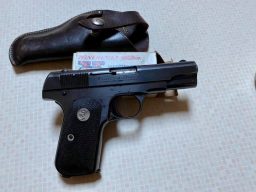
“My favorite firearm is a Colt .380 automatic. It’s handy, small enough to be carried in the pocket or in a shoulder scabbard, it’s powerful enough to be plenty effective at close-range. (If you file a scratch across the nose of the bullet it’ll dum-dum and tear out a chunk you could put your fist in.)”
Howard described putting his Colt .380 to use in a letter from 1935:
“I was awakened out of a sound sleep by the urgent voice of a neighbor on the front porch who called out that there were a couple of thieves in my garage. He said he and his wife had returned home late (they live in a small house west of ours, across a side-street) and were sitting shelling peas before they went to bed, when two men glided up on their back porch and tried the door. . . The men abandoned the store, passed through his backyard and began to try to break into my side of our garage, which is behind our house, giving onto the side-street. I jumped out of bed, grabbed the first weapon I chanced on, which happened to be a Colt .380 automatic, and went charging out to the garage in plain sight and with no attempt at concealment, not even taking advantage of the fences and trees. If they’d still been lurking in the garage. They could have shot me to splinters before I ever saw them. It was a plain boob-trick, which I’ll never repeat, and which I wouldn’t have pulled then, if I hadn’t been half-asleep. There was no need for such blundering tactics; there are plenty of trees and a good big gate I could have come up behind.”
Robert E. Howard did take a pragmatic view of concealed carry:
“Nine times out of ten a gun won’t do you any good in trouble. If you’re held up, the other fellow generally has the drop on you anyhow. But there’s always a chance that it might come in handy.”
Please give us your valuable comment